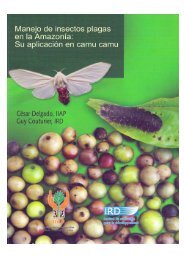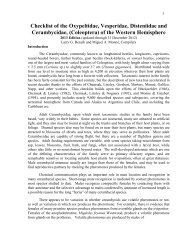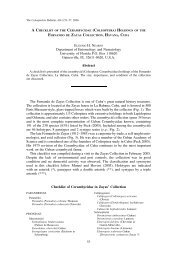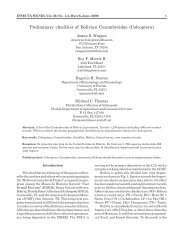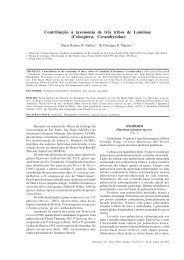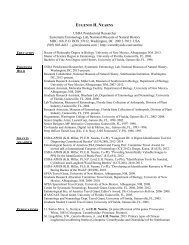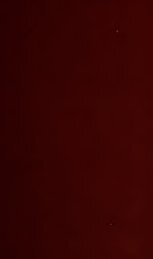Create successful ePaper yourself
Turn your PDF publications into a flip-book with our unique Google optimized e-Paper software.
LAWRENCE S. DILLON <strong>AND</strong> ELIZABETH S. DILLON 77<br />
angles obtusely eleva.ted, medially deeply norohed. Elytra with sides nearly<br />
straight, gradually narrowed to apices, which are separately rounded; disk sub<br />
gibbose at base, entire basal half densely, irregularly, and coarsely punctate, the<br />
punctures finer and a. little more sparse behind middle, obsolcte only at very apex;<br />
bumeri slightly promincnt, anterior margin arcuate, slightly oblique, angle with a<br />
broad feebly elevated tubercle, pooteriorly without trace of carina. Prosternum<br />
simple. Procoxae subglobosc, tumid posteriorly, not tuberculnte Ilutcriorly; femora<br />
robust, clavate, profemora less strongly clavate but stouter basally, not at all<br />
rugose; meta tibiae somewhnt expanded apically and densely setose there. Fifth<br />
slerni!e half again as long ns fourth, apex broadly emarginate, with a distinct<br />
median imprcs.sed line, and a broad triangular impression on apical half. Antennae<br />
as long as body, distinctly fimbriate beneath to sixth segment; scape slender,<br />
gradually clavate from middle; third segment equal to firs in length, strongly<br />
bisinuate; rest gradually shorter, the fourth arcuate, eleventh tapering to apex.<br />
LENGTH 18.5 mm.; width 9 mm.<br />
l'ype locality.-Eg{t.<br />
BRAZIL: 9; Teffe, December, 1924; [A.M.N. H.J .<br />
Charoides distincta Dillon and Dillon, spec. nov.<br />
PLATE IV, PlOunE 15.<br />
Resembles C. picticornis somewhat in sculpturing and body<br />
form. From this species it is different in having the general<br />
pubescence above fulvous i elytra with a distinct, broad, oblique<br />
band of dark brown, followed by an indistinct, broken line of gray<br />
ish pubescence i antennae with third segment on basal half and<br />
bases of following segments pale yellow annUlate, the annulations<br />
of all distal segments nearly equal in extent ; scutellum less strongly<br />
elevated at sides ; elytra with basal gibbosities more distinct ; and<br />
proDotum with discal tumescences less distinctly subdivided by an<br />
oblique impression. Moreover, the third segment of antennae is<br />
distinctly longer than scape, and the claw segment of tarsi is Dlore<br />
broadly piceous at apex.<br />
FEMALE. Elongate-ovate, robust, convex; dark reddish-brown, hcad [uscous ;<br />
the entire body above densely fulvous 1omentose. Head with an indistinct brown<br />
mark each side of median line and very indistinctly mottled. Pronotwn immacu<br />
late. Elytra indistinctly, broadly varied with fulvous-gray, each with a broad,<br />
somewhat interrupted, dark brown band running from well behind humerus obli<br />
quely to before middle at S\lture, behind this an indistinct broken, strongly undula<br />
ting line of pale grayish pubescence, more distinct toward suture, apical third of<br />
disk with scattered, irregular patches of dark brown and short strenks of pale gray<br />
ish pubescence. Body beneath dark reddish-brown, thinly covered with fulvous<br />
pubescence; abdomen fuscous, medially sparsely clothed with short, hoary-gray<br />
pubescence, laterally broadly vittate with fulvous, on third and fourth sternit-es the



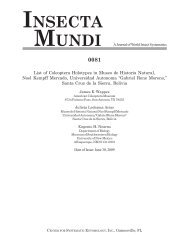
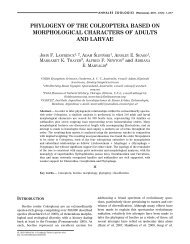


![Coleoptera. Vol. I. [Longicornia. Part I.]](https://img.yumpu.com/41202793/1/180x260/coleoptera-vol-i-longicornia-part-i.jpg?quality=85)
